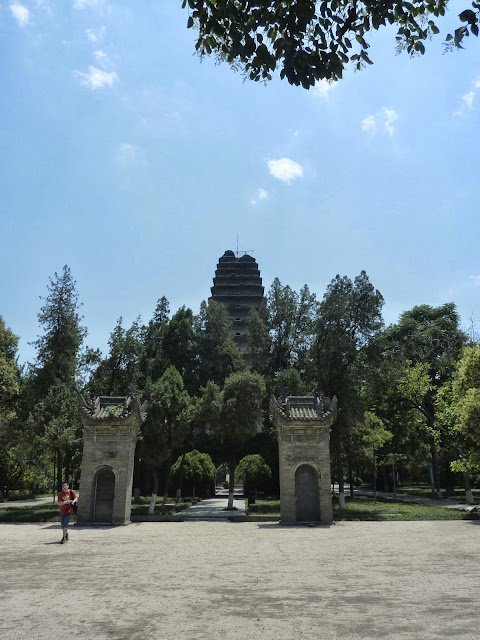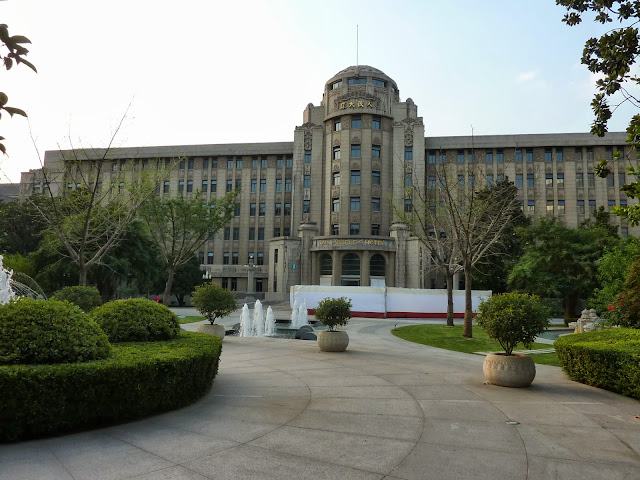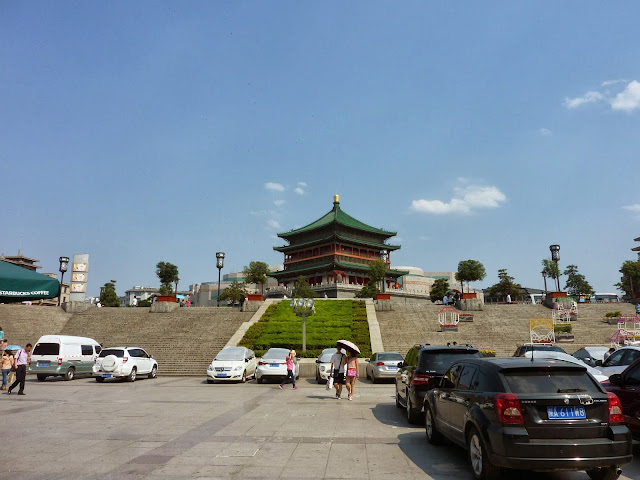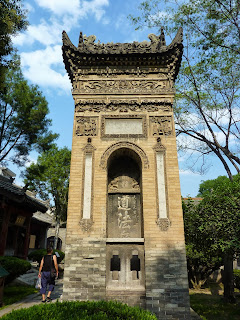 |
| First sightings - Xiaoyan pagoda. Built around 710 AD. |
The Little Wild Goose Pagoda isn't small by any means: the
'little' is relative. Unlike its larger
brother, this pagoda stands in a much more natural setting amidst a sprawling
garden. No granite and fountains here,
only shady paths, trees and plenty of birdsong.
It was a haven amidst the bustle of the city and we just sat, stretched
our legs and relaxed.
 |
| In 1487, the 15-storey pagoda was split by an earthquake/ Appears that it was glued together in the '60s. |
Early portraits

Next door was a small lake with a more manicured
garden. Geese strutted around waiting to
be fed. Dustbins dotted the garden
expanse and they were being used. There
was very little litter, something that struck us again and again in China. Better civic sense? The threat of fines? More efficient cleanup? Convenient dustbins? All of the above? Whatever it was, it seemed to work. Even the most crowded places we visited were much
cleaner than their Indian counterparts.
The Xian museum did not rate any special mention in the
guidebooks. We wandered in for a quick
look-see and some air-conditioning (entry was free!). We ended up spending the better part of an
hour walking around. Apart from the model
of tenth century Xian, there were exhibits of items excavated from the vicinity
going back some 3000 years. A profusion
of Buddhist relics from the Tang dynasty accompanied remnants of pottery,
building materials and other artifacts unearthed as the foundations were laid
for today's Xian. As with other museums
we visited in China, everything was neatly laid out and labeled. Sadly, the contrast with Indian museums was
only too evident.
 |
| Gilded Bodhisattva from the Tang period |
 |
| "Gold traced and painted statue of Avalokiteswara". Northern Zhou dynasty |
 |
| A stele with Buddhas on all four sides - from the 4th century |
 |
| The little lake beside the museum |
 | ||||
| The pagoda, with modern Xi'an behind |
We were making our way out of the grounds and almost missed
the small building off to one side.
Exhibition on the Cultural Revolution, said a banner. My wife's curiosity overcame my reluctance and
we went in to take a look. The exhibits
- photographs, a few articles and commentary (in English!) - occupied the
corner of a room. The unequivocal
message was this: Chairman Mao was a great man who unified the country and
helped drive out the Japanese, but his Cultural Revolution was a big
mistake.
Reformers led by Deng Xiaoping
learned from the social and economic chaos caused by the Revolution and
initiated the reforms that set China on the path to growth and prosperity. So there it was in black and white: official
acknowledgement that Mao had erred, that Maoism had outlived its usefulness,
and that it was time to move on. Perhaps
we need to send Indian Maoists and Marxists to China for some re-education.
Apart from his ubiquitous presence on currency notes and his
portrait and mausoleum in Tiananmen Square, Mao was absent in China. There was plenty of history and culture being
resurrected and burnished wherever we went. It appeared to me, though, that the nominally
communist ruling party was gradually airbrushing its communist past out of its
history.
 |
| The drum tower |
Old Chinese cities marked the beginning and end of the day
with the chiming of bells and the beating of drums. (Earlier still, battles were fought only at
specified times, and the bells and drums marked the beginning and end of each
day's battle: the custom survived the era of wars.) The well preserved (or well restored) Bell
Tower of Xian sits at the heart of the walled city, encircled by a never-ending
stream of traffic and surrounded by monumental Soviet style buildings dating
from the 1950s. A short distance away,
adjacent to buildings housing McDonalds, Starbucks and Haagen Dazs outlets,
sits the (equally well preserved/restored) Drum Tower. These are large, impressive, structures and
hold their own even in their twenty first century surroundings.
Exploring the Muslim Quarter Walk a little further, turn right past a large
mall, and you find yourself in a narrow alleyway, dodging scooters and
motorized rickshaws. This is the Muslim
Quarter of Xian, another remnant of the time when the city was the terminus of
the silk route. The looks and sounds of
the modern city are completely absent here.
We felt we were in some Middle Eastern bazaar. Shops and restaurants spilt out onto the
street. Mounds of dried fruits and dates
filled open sacks. Skewered kababs
awaited their turn in the oven, as did circles of unleavened bread.
Walk a little further, turn right past a large
mall, and you find yourself in a narrow alleyway, dodging scooters and
motorized rickshaws. This is the Muslim
Quarter of Xian, another remnant of the time when the city was the terminus of
the silk route. The looks and sounds of
the modern city are completely absent here.
We felt we were in some Middle Eastern bazaar. Shops and restaurants spilt out onto the
street. Mounds of dried fruits and dates
filled open sacks. Skewered kababs
awaited their turn in the oven, as did circles of unleavened bread.
The obsessive tidiness of the main thoroughfares was absent
here. The Chinese street signs were the
only indication of where we actually were.
The alleyway was too narrow for traffic, but that didn't stop the laden
scooters and rickshaws attempting to make their way through the pedestrian
crowds.
We came to a junction and turned into another crowded
alleyway moving, we hoped, towards the Great Mosque. There was no sign of any large mosque (or any
large structure) anywhere. More of the
same shops, passageways leading to small habitations, bicycles and scooters,
the odd tree, but no mosque. We looked
at our map. It had to be here somewhere,
except that there was absolutely nothing anywhere resembling a large green
space with a mosque. We finally stopped
and asked for directions. Sign language
and much pointing at the map, in case you were wondering. As in the rest of Xian, English is limited to
the road signs.
We were pointed down an even narrower covered alley, its
shops filled with tourist bric-a-brac. T-shirts
featuring Obama and Mao, playing cards with Saddam Hussein's smiling face, the
Little Red Book translated into the most unexpected languages, mugs, mats,
scarves and much else. There was none of
the competitive hustle and bustle of a true middle-eastern bazaar. Negotiations were civilized. If we only wanted to look, no one bothered
us.
We then came to a gate with a polite gentleman wanting to know where we were from. He seemed pleased to hear that we were from India. And, quite unexpectedly, there we were, in the first (of three) courtyard of the Great Mosque.
The mosque dates from the eight century, but as with
everything else in China, it is difficult to tell what has been restored, added
or repaired or whether even any part of the original structure still survives. That apart, this is a mosque like no
other. This is very Chinese set of
buildings and even what passes for a minaret is a Chinese tower. Arabic calligraphy here and there is the only
indication of its purpose.
It was quiet and restful inside, with plenty of trees
providing shade. The sounds of the
bazaar and the larger city are absent.
The chatter of birds and the distant sound of prayer were the only
sounds.
I couldn't help thinking that this place was a kind of
terminus. Islam came this far but,
running up against more ancient beliefs, didn't go any further. These buildings with their syncretism of
Chinese styles and Islamic calligraphy marked an outpost. Today, we are told, there are only about
20,000 Muslims in Xian. Judging from the
white caps and headscarves we saw near the mosque and their absence elsewhere
in the city, it looks as though most of them live and do business in this
crowded jumble of streets.
It was past six, the sunlight slowly softening and painting the Bell Tower in mellow hues. Across, in a large 1950s era edifice, was the post office. We wanted to send a few postcards and wondered if we were too late. We needn't have worried. As elsewhere, pragmatism ruled. There were others sending parcels, posting letters and sticking stamps on postcards. People needed to use the post office at this hour, and it was open as a result. No protests in the People's Republic about long working hours. (Interestingly, the postcards we sent to the US reached in a week. The postcards to India took three months. I wonder why.)
 |
| The Xi'an People's Hotel - a communist relic, now under renovation in private hands |
To be sure, life is far from perfect in China, but by and
large there is a sense that the government's job is to do something for its
citizens. We walked back to our hotel
along broad, tree-lined sidewalks, and couldn't help thinking that this small
pleasure, a quiet evening stroll, was impossible in our native Chennai.


























very evovative writing. Enjoyed and felt I was there.
ReplyDelete